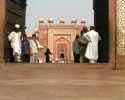The magnificent Agra Fort, built by Akbar, and extended by Shah Jahan, the emperor who built the Taj Mahal. It's built mainly in red sandstone, hence the colour. Get used to sandstone, you're going to see a lot of it!
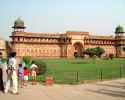
Here is Jean in one of the pathways through the fort. Tourists can only visit one third of it, the rest is reserved for the military. Agra Fort and the Taj Mahal were my first indications that something could be kept clean in India!
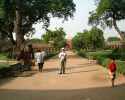
This is our first sight of the Taj Mahal, and the tourists all flock to look at it. Fellow-tourist Danielle said, "the moment I saw it, all my uncertainties about the trip melted away."
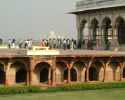
The Taj Mahal as seen from the Agra Fort. The Taj is on the bank of the river. The original idea was to build a black Taj on the other bank (to the left in the photo) and a bridge between them. What a sight that would have been!
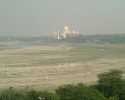
Here I am sitting on Jehangir's throne (well, the base for it anyway), looking east towards the Taj Mahal. I hope Jehangir doesn't mind.

The front gate to the Taj Mahal -- impressive in its own right.
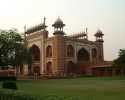
Finally, the Taj Mahal itself. Taken from just inside the gate, looking north. The Taj Mahal was built by emperor Shah Jahan for his favourite wife, Mumtaz Mahal, who died in childbirth after having previously given him 14 children. Shah Jahan began construction immediately after her death and it was completed 22 years later.
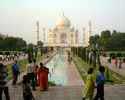
Another shot from just a bit closer. There's another theory that says the emperor had his wife killed, and then built the Taj Mahal out of remorse, guilt or as a public-relations exercise. But we'll ignore that possibility and leave this as the "world greatest monument to love."
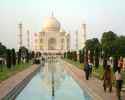
Well, Taj Mahal does mean 'Crown Palace'; so here I am wearing it as a crown. The 'Black Taj' was never built as the emperor's son, Aurangzeb, thought it was too expensive and had the work stopped and the emperor imprisoned. Aurangzeb also killed 3 of his brothers and then ruled for 60 years!
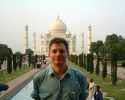
A side view of the Taj Mahal, taken from the mosque on the western side. At this point we had to remove our shoes to get any closer. All Muslim mosques and Hindu temples must be entered shoeless.
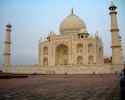
The Taj Mahal has beautiful gardens around it, which most people don't realise as most photos you see are of the Taj itself. But it was important for a tomb to have lush garden surrounds; they represent the lush gardens of Paradise.
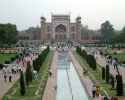
This building to the east of the Taj Mahal looks pretty, but it has no function. It was built purely for symmetry with the mosque to the west.
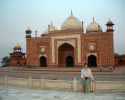
Sunset shot as we leave the Taj Mahal. Due to the massive amount of air pollution, the sunsets are rather tame, unfortunately.
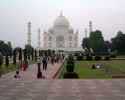
Now we move on to the town/palace/fort of Fatehpur Sikri. Built by Akbar, the grandfather of Shah Jahan, it was abandoned after 16 years when the nearby lake, and hence the water supply, dried up.
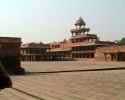
This spritely fellow was the guide at Fatehpur Sikri when the British were in charge, and he's still at it 60 years later!
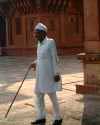
The Queens' Palace housed the 2 queens, one on each side (one was Moslem and one was Hindu; they didn't like each other). I'm in the photo to give scale.
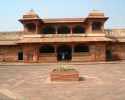
I go out on a limb to get this shot.
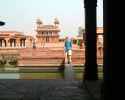
Fatehpur Sikri has very nicely kept up gardens, other forts cannot say the same.
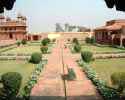
Another view of the gardens, with the main pavilion in the background and a poser in the foreground. Fellow travellers Leeanne and Satti are behind me.
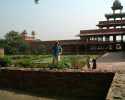
This is the Buland Darwaza, tallest gate in India at 54m. Golly!
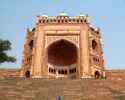
And this is the mosque that the big gate was hiding, the Dargah Mosque. We didn't go in; too much taking off and putting on of shoes.
